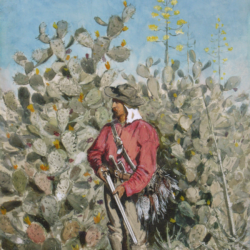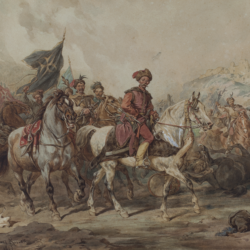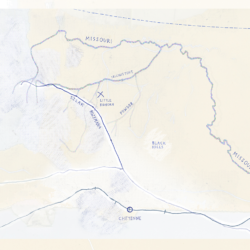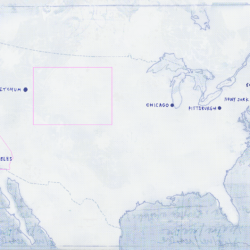
Borderland coexistence
It would seem that one of the lessons Sienkiewicz learned in America, which is apparent on the pages of the Trilogy, regards the two models of coexistence in the borderlands. There are two patterns of a culture clash which Sienkiewicz experienced in the American West and their echoes, in varied proportions, sometimes contaminated, can be heard in the Trilogy. The first is the coexistence and difficult vicinage of the Anglo- and Iberophone Californians. The second – the necessity to subdue the barbarian hordes threatening the oikumene to such a degree that it would be difficult to coexist with them, and at the same time, being a part of this world since time immemorial, therefore inevitably forming a constituent part of existence on these lands. This is, obviously, the Native American pattern.
The former, Californian pattern would then be a vicinage of cultures that is difficult and yet still functioning for more than one generation, where each culture feels “at home” in that area of land. A vicinage of cultures differing in terms of faith, customs, social structure, and also language (though in Sienkiewicz’s writing to a lesser degree than in the Californian reality), nevertheless, despite the apparent and continuous tensions, able to coexist. Fascinating though its otherness and separateness might be, for all its alienness, it is not uncivilized or barbarian; it can also be given the name of “culture” according to the rigid hierarchical criteria of the 19th century.
The latter model is the clash with barbarians. A clash with an alien, terrifying, wild culture that does not even deserve such status in accordance with 19th-century nomenclature. Simultaneously, however, it is fascinating because of its exoticism (it is worth returning here to the already quoted letter of Sienkiewicz from the Ketchum station in which he describes his first encounter with a Native American) and, possibly, power. Insofar as it is possible to describe the presence of the first model in Sienkiewicz’s accounts harmoniously (the initial dislike, discovery, surprise, acquainting and growing interest, finally acceptance while separateness is preserved), the second model and the general perception of Native Americans in Sienkiewicz’s accounts are not entirely homogeneous. It would seem that in some way it reflects the lack of uniformity in the perception of Native Americans in America of his time. Fascination, compassion, paternalistic treatment of the “savages,” disbelief at their victories over the white people is mixed with awe, but also anxiety, an attempt at rationalizing their success, finally the belief that it is beyond the grasp of logical thinking. There is also nostalgia of a kind, notably present in the Californian descriptions where Native Americans are almost extinct. They are a trace of the truly Wild West that is passing away, that Sienkiewicz would not become acquainted with much, though he might have wanted to. This particular nostalgia was probably not necessarily shared by Americans. Yet Sienkiewicz, at least on the pages of Portrait of America, seems to share the belief that brought together even the Americans that differed the most in their assessment of the Native American question – that regardless of feeling compassion or hatred for them, they are the Savage and the Other which could not be and would not ever be fully assimilated.
It seems possible to draw – although not to the fullest extent – a demarcation line in the Trilogy between these two models. Not to the fullest extent since insofar as the model of life in close proximity with the barbarians would be used in the Tatar threads, the other threads connected with cultural clashes would feature both models simultaneously. For the record, as it is an issue for a separate interpretative study, one could mention the problem of Ukraine where the span stretches from excerpts possibly indicating Sienkiewicz’s reminiscence of the encounter with the Iberophone California and his fascination with it (Skrzetuski’s arrival at the Kurcewicz [Kurtzevitch] house) to scenes and characters which could never possibly have any connection with the Christian culture in California (Horpyna). One could claim that such differences stem from a strongly evaluative gradation from civilization to wildness and savagery, which is apparent within the same range of threads in the Trilogy (for example, Bohdan Khmelnytsky’s transformation). Thus framed, the Ukrainian people will be “Iberophone” or “Native American” depending on their actions (especially towards the Poles). Tatars, on the other hand, even if they fight side to side with Poles, will always be wild, alien, and not fully assimilated. One could seek in such framework, particularly permeating Fire in the Steppe (Pan Wołodyjowski), Sienkiewicz’s growing conservatism – but are not its sources apparent in Portrait of America where Native Americans, after all, forever remain wild savages?














